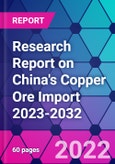In 2021, China imported 23.398 million tons of copper ore and its concentrates (referred to as copper ore, the same below), up 7.5% year-on-year, with imports of US$56.99 billion, up 56.3% year-on-year. In the first three quarters of 2022, China imported 18.895 million tons of copper ore, up 8.8% year-on-year, with imports of US$45.18 billion, up 7.2% year-on-year.
The publisher's analysis shows that the average price of copper ore imports in China is generally growing in 2018-2022. In 2018-2020, the average price of copper ore imports in China fluctuates slightly, but generally stays in the price range of US$1,520-1,670 per ton. In 2021, the average price of copper ore imports in China was US$2,435.9 per ton, up 45.3% year-on-year. In the first three quarters of 2021-2022, the average price of China's copper ore imports was stable at approximately US$2,400 per ton.
In 2021, China imported copper ore from a total of 59 countries and regions. According to the publisher's analysis, Chile, Peru, Mexico, Mongolia and Kazakhstan are China's major sources of copper ore imports by import volume. Among them, Chile is China's largest source of copper ore imports. 2021, China imported 8.871 million tons of copper ore from Chile, accounting for 37.9% of total imports and US$21.26 billion, accounting for 37.3% of total imports.
China is the world's largest copper consumer and importer. China's local copper mines are mainly small and medium sized, and the grade of copper ore is less than one-third of the grade of ore from the world's major copper producing countries, so China is heavily dependent on imports of copper ore, with China's copper ore import dependence exceeding 90% in 2021. With the development of new energy vehicles and other industries, China's demand for copper continues to grow, and The publisher expects that China's copper ore imports will continue to rise from 2023-2032.
Topics covered:
- China's Copper Ore Import Status and Major Sources in 2018-2022
- What is the Impact of COVID-19 on China's Copper Ore Import?
- Which Companies are the Major Players in China's Copper Ore Import Market and What are their Competitive Benchmarks?
- Key Drivers and Market Opportunities in China's Copper Ore Import
- What are the Key Drivers, Challenges, and Opportunities for China's Copper Ore Import during 2023-2032?
- What is the Expected Revenue of China's Copper Ore Import during 2023-2032?
- What are the Strategies Adopted by the Key Players in the Market to Increase Their Market Share in the Industry?
- What are the Competitive Advantages of the Major Players in China's Copper Ore Import Market?
- Which Segment of China's Copper Ore Import is Expected to Dominate the Market in 2032?
- What are the Major Adverse Factors Facing China's Copper Ore Import?
Table of Contents
Methodology
Background research defines the range of products and industries, which proposes the key points of the research. Proper classification will help clients understand the industry and products in the report.
Secondhand material research is a necessary way to push the project into fast progress. The analyst always chooses the data source carefully. Most secondhand data they quote is sourced from an authority in a specific industry or public data source from governments, industrial associations, etc. For some new or niche fields, they also "double-check" data sources and logics before they show them to clients.
Primary research is the key to solve questions, which largely influence the research outputs. The analyst may use methods like mathematics, logical reasoning, scenario thinking, to confirm key data and make the data credible.
The data model is an important analysis method. Calculating through data models with different factors weights can guarantee the outputs objective.
The analyst optimizes the following methods and steps in executing research projects and also forms many special information gathering and processing methods.
1. Analyze the life cycle of the industry to understand the development phase and space.
2. Grasp the key indexes evaluating the market to position clients in the market and formulate development plans
3. Economic, political, social and cultural factors
4. Competitors like a mirror that reflects the overall market and also market differences.
5. Inside and outside the industry, upstream and downstream of the industry chain, show inner competitions
6. Proper estimation of the future is good guidance for strategic planning.

LOADING...








